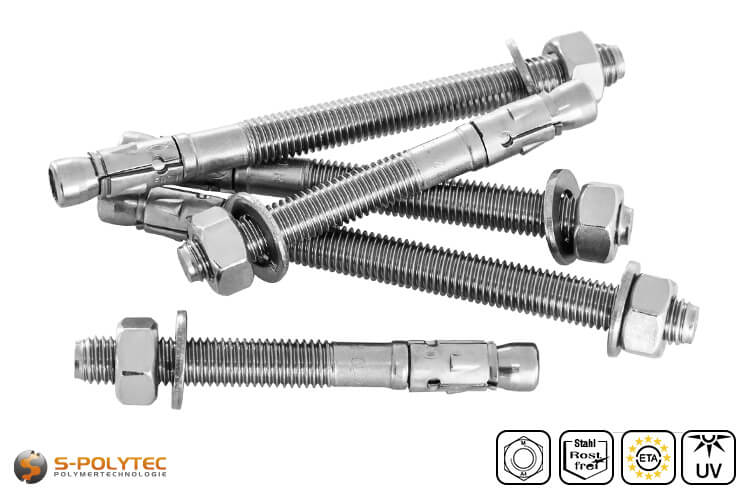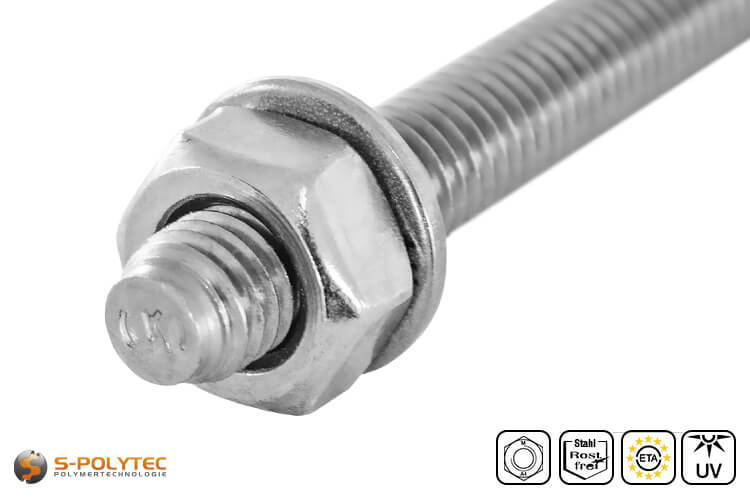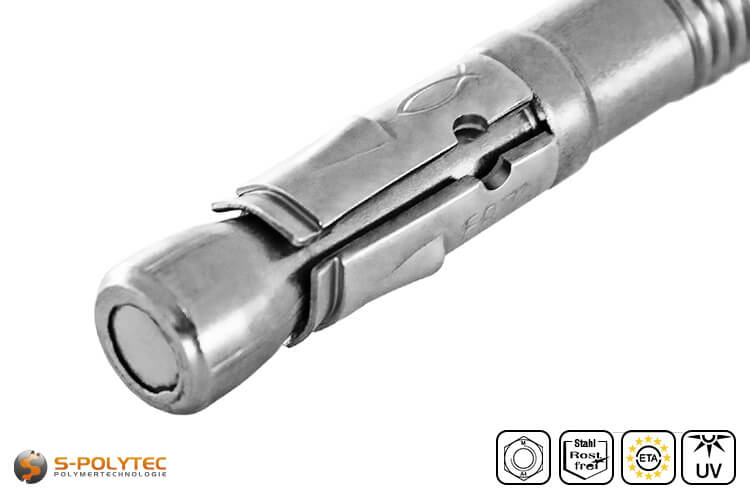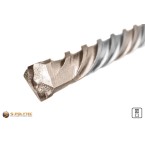
fischer Bolt anchor FAZ II Ø 12.0mm (Stainless steel)
The fischer FAZ II bolt anchor with 12mm diameter is ideal for applications that require enormous load-bearing capacities. The heavy-duty anchor is made of stainless steel and can therefore be used without hesitation indoors and outdoors, as well as in cracked and non-cracked concrete.
✓ Non-rusting steel
✓ for indoor and outdoor applications
✓ for cracked and non-cracked concrete
✓ with nut and washer
✓ With ETA admission
✓ With ICC admission
✓ with Seismic admission C1/C2
We offer the fischer FAZ II Wedge Anchor with 12mm diameter in various effective lengths from just one piece.
The item is in stock
Dispatch within 2-3 working days
- calculate the price
- from 10 Items €7.97/ pc. (Base Price €7.97/ pc.)
- from 20 Items €7.56/ pc. (Base Price €7.56/ pc.)
All prices include 19% VAT.
0,00 € / pc.
0,0000 kg / pc.
All prices include 19% VAT.
- Description
Fischer Wedge Anchor FAZ II Ø 12mm - When it gets really heavy
Version with screw nut ✓ Stainless steel ✓ ETA-approval ✓
Our fischer FAZ II type R bolt anchor is available in several lengths with a diameter of 12mm and is suitable for particularly heavy loads. The metric thread of size M12 varies, depending on the anchor size, in terms of thread length and effective length. The Wedge Anchor is manufactured from stainless steel and is supplied with A4 stainless steel nut and washer. This design is excellent for push-through installation. Pre-insertion mounting as well as spacer mounting is also possible with the robust anchors.
The 12mm heavy-duty anchor from fischer is suitable for assembling particularly heavy loads and can be installed equally well in cracked and non-cracked concrete. With a variable anchoring depth of 50mm to 70mm, the steel anchor ensures maximum flexibility in adapting to the necessary load capacities. The stainless steel manufacturing maximises the application possibilities, because in contrast to bolt anchors made of galvanised steel, the fischer FAZ II 12/X R can be used outdoors without hesitation.
Of course, the steel anchor with a large diameter of 12mm also has an ETA rating, the ICC approval as well as the Seismic approvals in categories C1 and C2. This means that the bolt anchor is approved for both non-load-bearing and load-bearing fixings, even in regions with increased seismicity.
12mm bolt anchors are rarely needed - so why buy whole boxes?
We offer the stainless steel anchors in any quantity, regardless of diameter or length, and unlike most other dealers, we do not require fixed packaging units or minimum purchase quantities. In addition, we offer the high-quality heavy-duty anchors at attractive graduated prices with generous quantity discounts.
Scope of delivery:
- 1 x fischer Wedge Anchor FAZ II Ø 12.0mm Type R in selected length
- 1 x A4 stainless steel washer with 24mm outer diameter
- 1 x A4 stainless steel nut with 19mm spanner size
NOTE: A hammer drill suitable for concrete with a diameter of 12mm is required for drilling.
Technical data of the fischer FAZ II Wedge anchor
- Dowel type: Wedge anchor
- Name: FAZ II 12/XX R
- Material: Stainless steel
- Anchor size: see additional information
- Ø Thread: M12
- Ø Dowel: 12.0mm
- Dowel length: see additional information
- Usable length: see additional information
- Anchorage depth: min. 50mm-max. 70mm
- Operating principle: Cone bolt with expansion clip
- Version: With screw nut
- Width across flats: 19mm
- Ø Drilling: 12.0mm
- Borehole depth: see additional information
- ETA admission: Yes
- ICC admission: Yes
- Seismic admission : Category C1 (less stringent), C2 (more stringent)
- Mounting type(s): Push-in mounting, push-through mounting, spacer mounting
- Building material: cracked concrete, non-cracked concrete, natural stone with dense structure and much more
NOTE: Some of the technical data requires the anchor size to be selected before it can be displayed in the Additional Information tab. This includes the information on the required drill hole depth and the effective effective length.
Installation instructions for fischer Wedge anchor FAZ II 12/X R
The installation of bolt anchors is done in four simple steps. In the first step, the fixing positions must be drilled with a hammer drill. This should have a sufficient spiral length in relation to the required drill hole depth. For the 12mm bolt anchors, the drill must also have a nominal diameter of 12mm. The holes should always be drilled straight to the mounting surface so that the anchor can be inserted straight. This ensures that the tightening torque can act on the anchor plate of the mounting part over the entire contact surface of the nut and washer.
Select the fixing positions so that an edge distance of at least 55mm is maintained. If this value is not maintained, the load on the fastening can lead to cracking and spalling of the concrete, which rules out safe installation. The frictional connection during expansion of the steel expansion clip also acts with high forces on the inner wall of the borehole. This expansion, which is initiated by pulling the solid conical bolt into the expansion clip, causes the very high load-bearing capacities of a heavy-duty anchor. For the same reasons, sufficient spacing should also be ensured between the individual fixings. For a 12mm stud anchor, the minimum centre distance is 50mm, regardless of whether the installation is in cracked or non-cracked concrete.
In the second step, the borehole must be thoroughly cleaned of drilling dust, because the expansion clip should expand unhindered in the inner wall of the borehole without any residues of drilling dust in between, which can cause the fastening to loosen over time.
In the third step, the anchor is inserted into the hole with light hammer blows or a suitable setting tool. An effective anchoring depth of 50mm must be observed. With increasing anchorage depth, the permissible tensile loads increase until the maximum value is reached at an anchorage depth of 70mm. If necessary, the anchor can be driven in further if the hole depth is sufficient, but this does not increase the tensile loads any further. Whether the anchor is driven through the mounting part or into the hole before the mounting part is placed does not play a significant role.
In the last step of the anchor fastening, the nut must be tightened with a spanner size of 19mm until the assembly torque of 60Nm is reached. It is recommended to tighten the nut with a torque spanner, because if the tightening torque is not reached, the conical bolt may not result in sufficient expansion of the expansion clip, which means that the load capacity of the fastening is not ensured.
Single load of a 12mm bolt anchor in cracked concrete
- Permissible tensile load at 50mm anchorage depth: 5.8kN
- Permissible tensile load at 70mm anchorage depth: 9.5kN
- Permissible transverse load at 50mm anchorage depth: 18.6kN
- Permissible transverse load at 70mm anchorage depth: 21.9kN
Single load of a 12mm bolt anchor in non-cracked concrete
- Permissible tensile load at 50mm anchorage depth: 8.3kN
- Permissible tensile load at 70mm anchorage depth: 10.5kN
- Permissible transverse load at 50mm anchorage depth: 21.9kN
- Permissible transverse load at 70mm anchorage depth: 21.9kN
NOTE: The manufacturer’s information on the permissible individual load is based on the use of a single Wedge Anchor in normal concrete C20/C25. For the calculation of anchorages with Wedge Anchors in concrete for concrete applications, the manufacturer fischer provides the free programme C-FIX, which can be downloaded from the manufacturer’s website.
Application examples for bolt anchor fischer FAZ II Ø 12mm
Wedge anchors with 12mm diameter are suitable for particularly heavy loads and are characterised by very high permissible tensile and shear loads. In most cases, these permissible loads are not achieved by weight alone, so other influences play a more important role here. A good example of the use of Ø 12mm bolt anchors is the path limitation for industrial trucks and forklift trucks in industrial and production halls, which serve as impact protection. These are usually made of steel and anchored in the foundation with heavy-duty dowels. The same applies to large industrial plants and machines where a secure anchoring to the hall floor is required.
Thanks to the secure anchoring in the concrete, the robust heavy-duty anchors are particularly suitable for installations subject to movement. This includes, for example, the fastening of playground equipment and climbing towers to a solid concrete foundation. Sliding gate systems for lorry loading zones or barriers to restrict access are also among the areas of application where the weight acts on the fixing less than the mechanical movement. The fischer FAZ II 12/X R bolt anchor is ideally suited for such purposes, because it has enormous values for the permissible load capacity and, because it is made of stainless steel, the steel anchor is also perfect for continuous outdoor use.
Another example for the use of heavy-duty dowels with 12mm diameter is the anchoring of pallet racks in concrete. In this case, the racks are usually assembled and aligned first, in order to securely anchor the uprights in the ground in the following step in the push-through assembly. The 12mm steel anchor allows a tensile load of approx. 1000kg in non-cracked concrete and an anchoring depth of at least 70mm. However, stud frames are anchored in the ground with a large number of heavy-duty anchors. How many fixing points are actually required without running the risk of the racking toppling over during or after loading with a forklift truck depends on the type of racking, size and weight load. Such assemblies should always be calculated in advance in relation to the application and carried out by skilled personnel.
For façade cladding, a 10mm diameter bolt anchor is perfectly adequate in most cases. However, mounting the substructure profiles with 12mm steel anchors can make perfect sense, especially if the cladding is to be made with very heavy panels with a higher thickness. Another possible reason for thicker steel anchors is if, for structural reasons, not enough fixings can be anchored in the concrete, so that the load has to be distributed over fewer bolt anchors.
NOTE: For all fixings that are implemented with bolt anchors, it must be checked in advance whether the concrete substrate corresponds to the load capacity. Especially for particularly heavy loads, as well as for installations with high mechanical stress, an anchor measurement is strongly recommended to determine the necessary fastening.
- Additional Information
Additional Information
Product-ID F-FAZ-12x00R Delivery Time Dispatch within 2-3 working days Material Stainless steel Size No Type of thread Metric thread Ø Thread M12 Version With screw nut Width across flats 19 mm - Reviews
- Attachments








